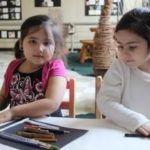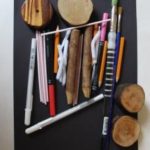What Are They Thinking?
posted by Lisa Ginet
It is hard to know what is going on in anyone’s brain. Even when asked to explain ourselves, we cannot always express our ideas clearly. Young children, who are still developing both their communication and reasoning abilities, have an especially hard time explain their own thinking in words or “showing their work” when they are solving problems. Why does it matter to understand what children are thinking about? It helps us to respond to them in ways that nurture competence and confidence.
So, how do we figure out what’s happening in children’s minds? We need to watch what they are doing and listen to what they are saying for clues, then interact with them intentionally. Here is an example from a preschool classroom:
From nearby the teacher has been watching Jenny and Samantha work with the materials at the sorting station.
The teacher has noticed the children taking the straight items from the collection without talking and putting them on the black paper. The teacher also noticed that Samantha takes each item and rolls it with her hand before she places it on the paper. After the paper is almost full with items, the teacher decides to approach the children.
Teacher: Tell me about your group.
Jenny: Son Palitos (These are sticks)
Samantha: Uh… no..no
Teacher: Samantha you don’t seem to agree with Jenny. What is your group then?
Samantha: A group that rolls
Teacher: Are you saying that what makes this a group is that all the things in it roll?
Samantha: yes, see (Samantha shows how different items in her group roll)
Teacher: Could this be part of your group? (The teacher offers a circular wooden object)
Samantha: (Samantha takes the wooden objects and tests if it rolls) Well, it kind of rolls.
(Samantha then adds the object to her paper)
Teacher: What should we call the group then?
Jenny: Cosas que ruedan (things that roll)
Teacher: I can see why you are naming your group: “things that roll.” There are sticks, pens, brushes, markers, pencils, straws and round pieces of wood but they all roll.
This teacher is drawing from a repertoire of intentional responses that help to surface children’s thinking:
- Stop & Look – Take the time to observe what a child is doing. Try to figure out what the child’s ideas or goals are.
- Say what you see – Use precise, descriptive language to describe what you notice. Provide labels to actions or structures that are mathematical.
- Re-voice what you hear – Use precise, descriptive language to echo and expand on what a child says.
- Check with the child – Always ask child to confirm your understanding of their ideas and intentions.
- Wait – Allow child the time to react or respond to an adult prompt
- Use comments / questions to invite / provoke children’s thinking
We will never be able to be inside children’s brains, but we can closely attend to their actions and words, and then intentionally respond in ways that draw out their ideas. The more we understand about what children are thinking, the easier it will be to help them love, understand and use math.


The abstraction rule.
I enjoyed the way that the teacher followed the reasoning of the children and re voiced their ideas. She invited herself into the group instead of taking the activity over.
I like the idea of re-voicing their ideas, that way it extends the activity and possibly creates new thinking and problem solving skills
I appreciate how the teacher didn’t lead the activity. She asked the right questions but they decided how they wanted to test if the items rolled and then categorized them in their own way. She was a facilitator and gave them language, but they made the rules
nice student teacher interaction and help for the children to articulate what they are thinking
It’s very helpful to have this concrete example, to explain what is meant by interacting intentionally with the children. As a teacher considering this scenario, I can see that I need to slow down the pace of my classroom to allow for time to simply observe and listen, in order to making my own interactions intentional.
This is a great reminder that we as teachers cannot assume what children are thinking or doing. We need to step back and observe what children are doing and ask questions to piece together what is going on. Children telling us their reasoning helps us not only understand their reasoning skills, but helps us use our as well!
Nice conversation. Great for the children because they were working together yet had some different ideas. Teacher helped them to share their individual thinking and to focus their shared work.